Question
Assume the firm can either take Project A or Project B. Project A will require the initial investment of $110,000 and will yield $32,000 at
Assume the firm can either take Project A or Project B. Project A will require the initial investment of $110,000 and will yield $32,000 at Year 1, $25,000 at Year 2, $23,000 at Year 3, $29,000 at Year 4, $35,000 at Year 5, and $26,000 at Year 6. Project B will require the initial investment of $120,000 and yield $34,000 at Year 1, $25,000 at Year 2, $16,000 at Year 3, $18,000 at Year 4, $39,000 at Year 5, and $68,000 at Year 6. If the interest/discount rate that applies to both project is 10.35%, which of these two projects is a better option if the decision is made based on the Net Present Value (NPV) basis? Assume the firm needs to make a "mutually exclusive" decision where taking both projects is not an option because of the firm's inability (i.e. lack of resources) to do so.
A.) Project A
B.) Project B
C.) Neither A nor B
D.) We do not have sufficient information to answer this question.
Which project will be better under the (non-discounted) Payback Period standard?
A.) Project A
B.) Project B
C.) Neither A nor B
D.) We do not have sufficient information to answer this question.
What about under the Discounted Payback Period standard?
A.) Project A
B.) Project B
C.) neither A nor B
D.) We do not have sufficient information to answer this question.
Step by Step Solution
There are 3 Steps involved in it
Step: 1

Get Instant Access to Expert-Tailored Solutions
See step-by-step solutions with expert insights and AI powered tools for academic success
Step: 2

Step: 3

Ace Your Homework with AI
Get the answers you need in no time with our AI-driven, step-by-step assistance
Get Started


